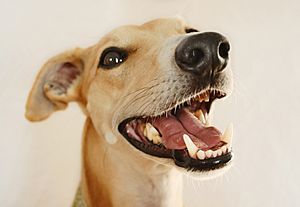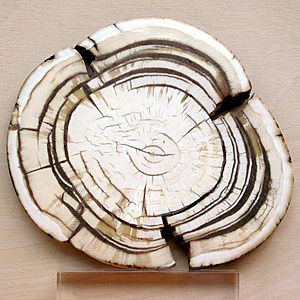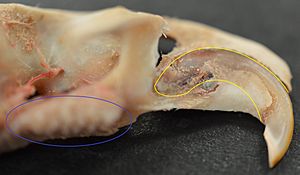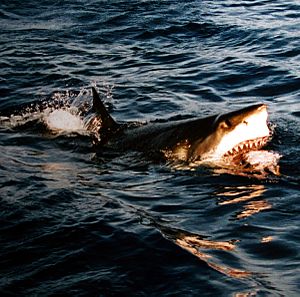Tooth facts for kids
A tooth is one of the hard, white parts in your mouth. Teeth (plural) help you chew food. To chew means to break up and crush food so you can swallow it easily.
Most animals with backbones (called vertebrates) and many other animals have teeth. Different animals have different kinds of teeth because they eat different foods. Some animals even use their teeth as a weapon. Human adults usually have 32 teeth. Children usually have 20 teeth.
Contents
How Teeth Grow
The first set of teeth for most mammals are called "baby teeth," "milk teeth," or "temporary teeth." Humans have 20 of these. The first baby teeth start to erupt (come through the skin of the jaw) when a baby is about 6 months old. When these teeth erupt, it can hurt. Babies often chew on things to make the pain feel better. This is called teething. Most children have all 20 baby teeth by the time they are two or three years old.
Around age 6 or 7, the permanent teeth start to erupt. By the age of 11 or 12, most children have 28 adult teeth. The last four teeth, called 'wisdom teeth' or third molars, usually come in between ages 17 and 21 for most people. Some people never grow wisdom teeth, or they might only have two instead of four.
What a Tooth Is Made Of
The white outer part of your teeth is called the enamel. Enamel is made of calcium phosphate and is very hard. Under the enamel is the dentine. The dentine is softer than the hard enamel. This means it can be hurt more easily by tooth decay (cavities).
Under the dentine is the pulp. The pulp has the nerves and blood vessels that go to the tooth. This is the part that causes the pain of a toothache. Cementum is found on the outside of the dentine where there is no enamel. Cementum helps hold the tooth to the bone of the jaw.
Kinds of Teeth
- Incisors: These are your front teeth, used for biting and cutting food.
- Canine tooths: These are the pointed teeth next to your incisors, used for tearing food.
- Premolars: These teeth are behind your canines, used for crushing and grinding.
- Molars: These are your back teeth, the largest ones, used for heavy grinding of food.
Keeping Teeth Healthy
If you protect and clean your teeth, they should last your whole life. Many people lose their teeth early because they don't do the right things to keep them healthy.
Here are some ways to keep your teeth healthy:
- Brush your teeth after every meal and at bedtime with a soft toothbrush.
- Floss your teeth after every meal (or at least once a day at bedtime). Flossing should be done before brushing!
- Drink water with fluoride. Or, use a fluoride mouthrinse (but not for children under age 6).
- See a dentist every 6 months for a check-up and cleaning.
- Eat good foods.
- Sugars like sucrose and glucose are bad for teeth.
- Milk and cheese are good for teeth because they have calcium.
- Unsweetened (no sugar) chewing gum helps clean teeth. It also makes more salvia and removes food bits.
- Try not to eat or drink anything with flavor between meals. This gives your saliva two to three hours to clean your teeth. Saliva can't do its job if there's always a film of food on your teeth.
- Not drinking enough water can lead to less saliva. Drink plenty of water every day.
Tooth Problems
Plaque is a soft, white substance that forms on teeth when they are not cleaned. It has bacteria in it that can hurt enamel. If plaque is not cleaned off, it can become tartar after about two days. Tartar is a hard substance that forms on teeth, mostly near the gums. Tartar makes gums unhealthy and helps more bacteria grow on the teeth.
You can clean plaque off with a toothbrush. If tartar forms on your teeth, a dentist must clean it off.
The bacteria on your teeth can eat into the enamel. Cleaning and flossing your teeth, eating good foods, and having a dentist remove plaque all help reduce bacteria. If there are too many bacteria, they eat enamel faster than your teeth can make it. This creates holes in the enamel called cavities. When a person gets cavities, they have the disease called dental caries.
Cavities form slowly in enamel. But once they go through the enamel, the soft dentin is hurt much faster. If a cavity is not fixed by a dentist, it can go into the root. This can permanently damage the tooth. If this happens, the tooth might need to be taken out. Or, the dentist might do a root canal, which is a surgery to replace the inside of the root to save the tooth. If the tooth is not fixed, a tooth infection can happen. This infection can spread to your face. It can even be very serious if not treated by a dentist or doctor.
How Teeth Started
The genes that control how teeth grow in mammals are similar to those involved in the development of fish scales. Scientists studied a tooth plate from an ancient fish called Romundina stellina. They found that its teeth and scales were made of the same tissues found in mammal teeth. This supports the idea that teeth developed from a type of scale.
Mammal Teeth
Teeth are one of the most unique and long-lasting features of mammal species. Scientists who study old fossils (called paleontologists) use teeth to identify fossil species and understand how they are related. The shape of an animal's teeth tells us about what it eats. For example, plants are hard to digest, so herbivores (plant-eaters) have many molars for chewing and grinding. Carnivores (meat-eaters), on the other hand, have sharp canine teeth to kill prey and tear meat.
Most mammals grow two sets of teeth during their lives. In humans, the first set (baby teeth) usually starts to appear around six months of age. This is called teething and can be painful.
Dog Teeth
In dogs, teeth are less likely to get cavities than human teeth. This is because dog saliva has a very high pH, which stops enamel from breaking down. Dog canine teeth are pointed and are used for tearing and grasping food.
Whale Teeth
Whale teeth are interesting. Some whales, like human teeth, have small bumps on the root surface. These bumps are made of cementum. Toothed whales, a group of cetaceans, have teeth that vary a lot. Some dolphins can have over 100 teeth!
The narwhal has a giant, unicorn-like tusk, which is actually a tooth. This tusk has millions of sensory pathways and is used for sensing things while feeding, navigating, and mating. It's one of the most complex teeth known! Beaked whales are almost toothless, with only strange teeth found in males. These teeth might be used for feeding or for showing off.
Primate Teeth
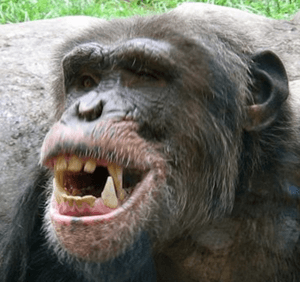
Humans (and most other primates) usually have 20 primary ("baby") teeth. Then, they get 28 to 32 permanent teeth, plus four more called wisdom teeth, which may or may not grow in.
Of the baby teeth, 10 are usually in the upper jaw (maxilla) and 10 in the lower jaw (mandible). For permanent teeth, 16 are in the upper jaw and 16 in the lower jaw. Most teeth have unique features that help tell them apart.
Horse Teeth
An adult horse has between 36 and 44 teeth. The enamel and dentin layers of horse teeth are mixed together. All horses have 12 premolars, 12 molars, and 12 incisors. Male horses usually have four canine teeth between their molars and incisors. Few female horses have canines. Some horses also have one to four "wolf teeth," which are small, extra premolars. These can sometimes cause problems with the horse's bit, so they are often removed.
You can estimate a horse's age by looking at its teeth. Between birth and five years, age can be guessed by watching how their baby teeth and then permanent teeth grow in. After age five, it's harder to tell, and you look at how the incisors wear down and their angle.
A horse's incisors, premolars, and molars keep growing as the chewing surface wears down. A young adult horse's teeth are long, but most of the tooth is hidden below the gumline. The rest of the tooth slowly comes out of the jaw, about 1/8 inch each year, as the horse gets older. When a horse is very old, its teeth become very short and can even fall out. Very old horses might need their food ground up and soaked in water to make it soft enough to eat.
Elephant Teeth
Elephants' tusks are special incisor teeth used for digging up food and fighting.
When elephants are born, they have 28 molar-like grinding teeth, not counting their tusks. These are arranged in four sets of seven teeth, which get bigger over time. An elephant slowly wears through these teeth during its life of chewing rough plants. Only four teeth are used for chewing at any given time. As one tooth wears out, another moves forward to take its place, like a conveyor belt. The last and largest of these teeth usually appears when the elephant is around 40 years old and can last for another 20 years. When the last of these teeth falls out, the elephant can no longer chew food and will die of starvation.
Rabbit Teeth
Rabbits and other lagomorphs usually lose their baby teeth before or shortly after birth. They are usually born with their permanent teeth. Rabbit teeth are perfect for their diet of many different plants. Since much of their food is rough and wears down teeth, rabbit teeth grow continuously throughout their lives. Rabbits have 6 incisors, 3 upper premolars, 3 upper molars, 2 lower premolars, and 2 lower molars on each side. They do not have canines. Their incisors wear down about three to four millimeters every week, while their back teeth take a month to wear down the same amount.
Rodent Teeth
Rodents have upper and lower incisors that can grow continuously throughout their lives. These teeth do not have fully formed roots. Rodents must wear down their teeth by gnawing on different materials. This helps keep the rate of wear and tooth growth balanced. Rodent incisors are used for cutting wood, biting through fruit skin, or for defense.
The teeth have enamel on the outside and exposed dentin on the inside, so they self-sharpen as the rodent gnaws. Some rodents, like the guinea pig, also have continuously growing molars. Rodents generally do not have canines or premolars. They have a space between their incisors and molars, called the diastema.
Walrus Tusks
Walrus tusks are actually canine teeth that grow continuously throughout their lives.
Fish Teeth
Fish, like sharks, can go through many teeth in their lifetime. They can replace multiple teeth, which is called polyphyodontia.
Amphibian Teeth
All amphibians have special teeth called pedicellate teeth. These teeth are flexible because of soft tissue and uncalcified dentine that separates the top part (crown) from the base of the tooth.
Most amphibians have teeth that are only slightly attached to their jaw. This is good for animals that mostly use their teeth for grasping prey, not for crushing it. It also allows them to grow new teeth quickly without using much energy. Teeth are often lost during feeding if the prey struggles.
Reptile Teeth
The teeth of reptiles are replaced constantly throughout their lives. Young crocodilians can replace teeth very quickly, sometimes a new tooth every month for each socket. As they get older, tooth replacement slows down to every two years or even longer. Overall, crocodilians might use 3,000 teeth from birth to death! New teeth grow inside the old ones.
Invertebrate Teeth-like Structures
True teeth are only found in animals with backbones (vertebrates). However, many invertebrates have similar structures that are often called teeth. For example, the hookworm Necator americanus has cutting plates or teeth around its mouth.
The European medicinal leech, another invertebrate parasite, has three jaws that look like small saws. On these jaws are about 100 sharp teeth used to cut into a host. The cut leaves a mark that looks like an upside-down Y inside a circle. After piercing the skin and injecting chemicals that stop blood from clotting and numb the area, they suck out blood, sometimes drinking up to ten times their body weight in one meal.
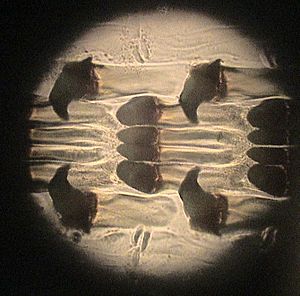
Molluscs have a structure called a radula, which is a ribbon with many chitinous teeth. These teeth are used for feeding, often for scraping or cutting food before it goes into the esophagus. The radula is unique to molluscs and is found in every class of mollusc except for bivalves.
Within the gastropods (snails and slugs), the radula is used by both plant-eating (herbivorous) and meat-eating (carnivorous) snails and slugs. The way the teeth are arranged on the radula ribbon varies greatly among different groups.
Predatory marine snails, like the Naticidae, use their radula along with an acidic liquid to drill through the shells of other molluscs. Other predatory marine snails, such as the Conidae, use a special radula tooth like a poisoned harpoon. Predatory land slugs, like the ghost slug, use long, sharp teeth on their radula to grab and eat earthworms. Predatory cephalopods, like squid, use the radula for cutting prey.
Related pages
See also
 In Spanish: Diente para niños
In Spanish: Diente para niños



